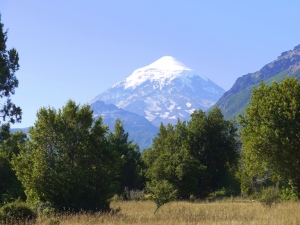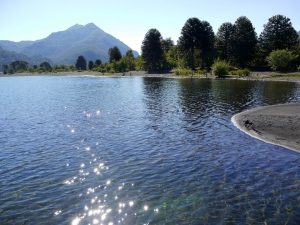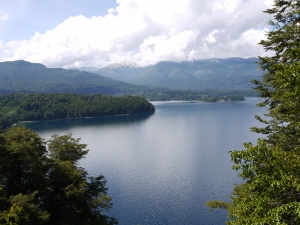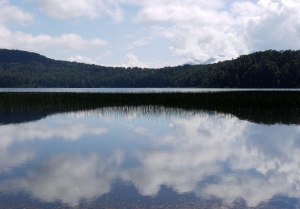There were a few seconds of pure panic.
I had just braved a disgusting restroom in the bus station in some mid-sized city about seven hours into the return trip from my week in Patagonia. The bus had pulled into a brightly lit station at around 11 p.m., just as I was dozing off, when the steward came up to the top level and blasted out some sentences in rapid-fire Spanish. I was fairly sure he said the bus was stopping for ten minutes, but asked an Argentine next to me; she held up ten fingers.
So, a quick trip to said facilities, and back to the platform area, ready to get down to sleep for, I hoped, a big chunk of the trip back to Buenos Aires.
But, the dock where my bus had been was empty.
I know I gasped out loud. There was a bus from the same company two docks over, so I ran over to it, but the destination sign said Mendoza, another city. Could I have been that stupid? What had that damn steward said, a ten-second stop? Why did I even get off the damn bus? There was a bathroom on board. My computer, my phone, my passport, half of everything stitch of clothing I have here in Argentina was on board that now-absent vehicle. Where the fuck was I, anyway?
The panic must have been pretty visible because out of the corner of my eye I saw an arm waving at me. I looked over in the fluorescent glare and recognized a guy who had been sitting a couple of rows back from me. “Don’t worry,” were his first words after I went over to him, like a castaway greeting the ship coming to save him. “The bus is coming back in ten minutes.”
Had that initial, white-hot fear been founded, it would have been a very crappy coda to an otherwise delightful week in Patagonia. (Slide show below.)
After a pleasant day in Bariloche (see previous post), I had rented a white VW Gol, Volkswagen’s entry-level car designed in Brazil that’s a hit in South America. This was no high-performance vehicle, more like a Ford Fiesta with slightly better styling, but it was cheap. I’d read that there were lengthy stretches of road coming up that were not paved, and some four-wheel drive, manly vehicle would have set my mind more at ease. To distract myself from the gravel surface coming up and the possible results of my miserliness, I just kept scarfing down the chocolates I’d bought in town until I was sick.
But then I reached my first destination on the Seven Lakes Drive without having to leave the comforts of asphalt. Villa la Angostura is a little up-market town next to the peninsula where I did my hike, also in the last post. I don’t know; it was pretty and all, but felt kind of like a tourist trap, although the trap has mostly been set for the wealthy Argentines who come here to ski or who have second homes. I mean, don’t get me wrong, the scenery cannot be beat. But the town itself didn’t offer much besides chocolate shops or stores featuring all the same Argentine handicrafts.
And let me tell you, I am not impressed (by the handicrafts, that is). Every time I’m in Asia, I just go wild seeing interesting things to bring back. I just keep myself in check so my apartment doesn’t begin looking like a Chinese restaurant.
But here, there’s been no temptation to pull out my wallet for any of the cheesy, chintzy stuff like badly painted wooden figures, vaguely “native” looking I-don’t-know-whats, knives (so many it’s scary), or cups meant for mate (the national tea-like beverage, wait, or is that Pepsi or Sprite, which everyone seems to drink much more of these days?).
Well, I did get the DVD of that Argentine movie that just won the Oscar for best foreign-language film. At least I’ll have something.
So, I did that hike, fell victim to a woman selling a bunch of dulce de leche products my expanding waistline does NOT need, and crashed.
The next day me and the Gol left Lake Nahuel Huapi and paved roadway behind, hitting the gravel, jerking and shuddering alongside fantastically beautiful lakes nestled amid forest-covered mountains – Lake Correntoso, Lake Espejo, lakes Falkner and Traful. They were all azure blue and shimmering under the bright, late summer sun. They’re perfect for long treks on their surrounding mountain ridges or for setting up tents on their tranquil shores – if I were into that kind of thing.
Wish I hadn’t been so worried about my seen-better-days car just shaking into a million pieces, or kicking up some rock that would put a huge scratch on its white (well, tan at this point) surface. I did get out a couple of times to snap some pictures, although a car would inevitably pass by and I’d be lost in a thick cloud of kicked-up dust for a few minutes. It was only half-way through this stretch that I realized the car actually had AC and I didn’t have to have the windows open and hold my breath whenever some SUV would roar by, leaving me literally eating his dust. The windows stayed up after that.
Back on asphalt and up to San Martín de los Andes, a truly charming town that’s cute indeed, but not treacly cute like Villa la Angostura. I stayed at this B&B called La Casa de Eugenia, and if you’re even in San Martín, this is the place to be. The place has an incredibly laid-back, nice host, beautiful design and furnishings that aren’t snotty, and a breakfast to die for. Thank you, guide book.
The food in the area: excellent. Ravioli stuffed with lamb in a blueberry sauce, local trout, or medium-rare Argentine steak with, yes, some version of potatoes, usually accompanied by a nice glass of Malbec.
It was then that I headed up to Junín, the angler’s paradise I mentioned in the last posting, as well as home to the Christian sculpture garden. It was also the place of death of the Blessed Laura Vicuña, a girl who lived to the ripe old age of 13 and was beatified by the Pope John Paul II. She gave herself to God because her mother was shacking up with a farmer to make ends meet. I don’t think she can be canonized because Laura’s backers can’t produce a miracle she performed.
But the real miraculous aspect of the region is the extinct (I certainly hoped so) volcano rising like a earth god above everything around it. It’s called Lanín, rises 3,776 meters, and elicited another audible gasp from me when I first spotted its snow-capped peak while jerking and shaking down yet another unpaved road. I was headed down the northern shore of Lake Huechulafquen after having stopped at the national park ranger station. I asked about hikes, but “easy, shortish ones.” The woman told me about one that, in the end, appears to have been designed for small children. I guess I came across like even more of a wimp than I thought.
As I walked around this forest path reading signs featuring the adventures of a comic forest elf and his “living room in the forest,” powerful Lanín kept watch behind me, resting after an eruption many moons ago which spewed volcanic rock all over the place. You can climb the peak, but it takes three days and you need to be outfitted with things like ice-axes and crampons, and prove to the rangers that you are mentally and physically prepared for the experience. I didn’t think I’d pass that particular test. I was content to appreciate it from afar, as well as the astoundingly beautiful lake not far away, placid and glistening under a brilliant blue sky.
Time was running short, so back in the car for a bumpy ride back to San Martín to get my stuff and make the three-hour trip back to Bariloche to catch the bus that afternoon. I had to put pedal to metal even around some hair-raising turns since I was running late. But by God, I didn’t want to miss that bus. Can you imagine missing your bus out in the middle of Patagonia?








